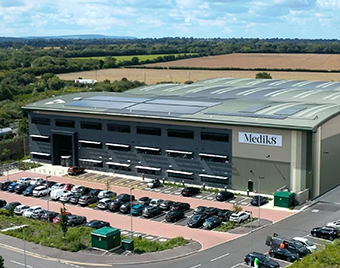Optimising Warehouse Operations
Harry Watts of SEC Storage outlines how to achieve strategic alignment in your warehouse, by adopting SEC’s ‘SAVES Cost’ approach.
Read More
16.01.2024
Workplace design and flexible spaces have become more crucial than ever in catering to the evolving work styles and needs of employees. Maintaining a flexible workspace that can adapt to these changes has huge potential to not only enhance company productivity, but also foster innovation and employee satisfaction.
This article delves into the significance of flexible office design, and provides you with insight into how you can effectively explore and implement flexibility and adaptability into your own workplace: Keep reading to instigate positive change and optimal workflow!
As work styles and needs continue to evolve, it is important for businesses to adapt their workplace design to meet these changes. Several industry trends have emerged that highlight the need for flexible design:

Understanding the changing work landscape requires businesses to recognise and adapt to the trends driving the need for flexible design. By doing so, companies can create work environments and teams that are conducive to productivity, employee satisfaction, and the ever-evolving nature of work, encouraging better talent retention and quicker results.
Creating a versatile and adaptable environment is crucial in a flexible workplace design: By incorporating elements of biophilic design, such as natural lighting, plants and organic materials, employers can create a more nurturing and inspiring space. Addressing the needs of different work styles of your workers; whether they are collaborative and would prefer open plan work spaces, focused and work better in quiet areas, or creative and do their best in a combination of these atmospheres, is an essential and important consideration in ensuring that employees can perform to their best.
Agile workspaces are defined by their flexibility and dynamic nature, offering various benefits such as increased collaboration and productivity.
When designing these spaces, it is important to consider factors such as furniture layout, lighting, and zoning (in a cost effective way!) – understanding the concept of activity-based working, where employees choose their workspace based on the tasks and responsibilities they need to accomplish, has a significant impact on productivity.
Ergonomic principles should be a priority when designing flexible workstations. Prioritising ergonomic furniture and equipment allows employers to ensure that their team members can work comfortably and avoid the risk of work-related injuries.
It is crucial to choose furniture that supports various work styles and tasks in these flexible workspaces, allowing employees to easily transition between different activities, as incorporating adjustable and adaptable furniture further accommodates the changing needs of the workforce and of individual employees.
Designing and incorporating collaborative spaces is essential to encourage teamwork and idea sharing – for example, when choosing furniture and deciding on layout for these areas it is important think about how to best promote interaction and engagement. Creating an inviting and comfortable space will encourage employees to collaborate effectively, while incorporating technology and tools such as video conferencing equipment and whiteboards can enhance collaboration efforts.
Technology plays a crucial role in supporting flexible work arrangements. Integrating technology into the workplace enables employees to work remotely and stay connected, meaning that embracing smart office solutions, such as automation systems and communication tools, can enhance productivity and communication among team members. It is important to address privacy and security concerns when implementing technology in the workplace to ensure the confidentiality of sensitive information.
Flexible workplace design has a direct link to employee well-being and satisfaction, and so incorporating wellness features like natural lighting, plants and break areas contribute to a healthier and more productive workforce. Smart design choices such as comfortable furniture and designated relaxation areas also play a significant role in fostering employee satisfaction in the workplace flexibility.
Implementing strategies that prioritise employee comfort and well-being will result in better overall job satisfaction.
Implementing a flexible workplace design requires careful planning and execution. The following steps outline how to successfully implement a flexible workplace that employees will be able to quickly adapt to:
Transitioning to a flexible workplace can pose a range of challenges; to overcome these make sure to consider the following:
Measuring the impact of a flexible workplace design is crucial for continuous improvement; make sure to consider the following:
A flexible workplace design is essential in today’s ever-changing work landscape, and by understanding the changing work styles and needs of employees, businesses can create a workspace solution that allows for adaptability, development of soft skills, and increased productivity.
The importance and benefits of flexible workplace design cannot be understated, as has potential to transform and not only promote collaboration and communication, but also provide a sense of autonomy and well-being for employees. By embracing change and adapting to the evolving work landscape, businesses can stay ahead of the curve and attract (and retain) top talent, and also supports their growth and success.
It is crucial for organisations to recognise the value of flexible workplace design and make it a priority in their overall workplace strategy as the work landscape continues to evolve: It is vital for businesses to constantly reevaluate their workplace design and make adjustments accordingly.
By staying open to change and embracing the challenge of new ways of working, organisations can ensure their success in an ever-evolving world.
Embrace the change and create flexible office spaces with help from SEC Group, and adapt to the evolving work landscape. Contact us today – your employees and your business will thank you.

Harry Watts of SEC Storage outlines how to achieve strategic alignment in your warehouse, by adopting SEC’s ‘SAVES Cost’ approach.
Read More
In the world of cosmetics, innovation and sustainability are the driving forces that push boundaries and set new standards. In this case study, we delve into a unique project and partnership that exemplifies these principles. Our collaboration with Medik8, a prominent cosmetics company known for its commitment to sustainability, brought together logistics, manufacturing, research and development (R&D), and the supply chain into a cohesive operation. This case study highlights the challenges faced, meticulous planning, effective communication, and the transformative journey that turned discussions into decisive actions.
Watch VideoWorkplace design and flexible spaces have become more crucial than ever in catering to the evolving work styles and needs of employees.
Read More